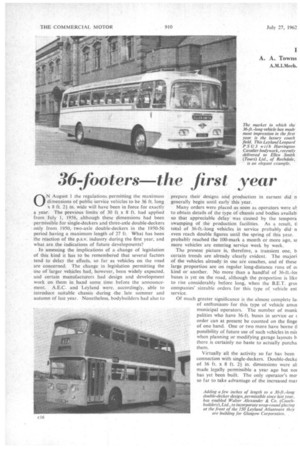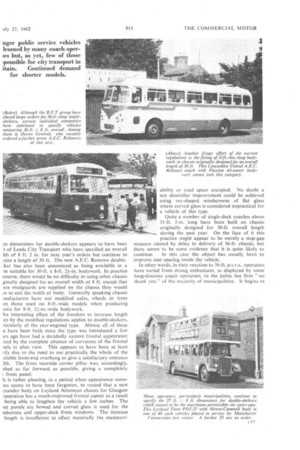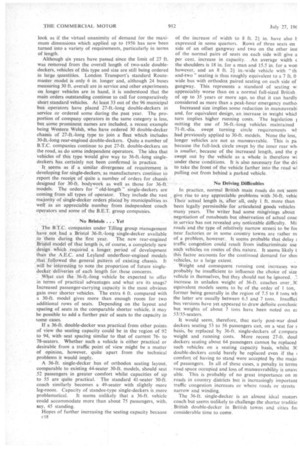36-froters the first year
Page 56

Page 57

Page 58

If you've noticed an error in this article please click here to report it so we can fix it.
ON August 1 the regulations permitting the maximum dimensions of public service vehicles to be 36 Et. long x 8 ft. 2+ in. wide will have been in force for exactly a year. The previous limits of 30 ft x 8 ft. had applied from July 1, 1956, although these dimensions had been permissible for single-deckers and three-axle double-deckers only from 1950, two-axle double-deckers in the 1950-56 period having a maximum length of 27 ft. What has been the reaction of the p.s.v. industry during the first year, and what are the indications of future developments?
In assessing the implications of a change of legislation of this kind it has to be remembered that several factors tend to delay the effects, so far as vehicles on the road are concerned. The change in legislation permitting the use of larger vehicles had, however, been widely expected, and certain manufacturers had design and development work on them in hand some time before the announcement. A.E.C. and Leyland were, accordingly, able to introduce suitable chassis during the late summer and autumn of last year. Nonetheless, bodybuilders had also to prepare their designs and production in earnest did n generally begin until early this year.
Many orders were placed as soon as operators were al to obtain details of the type of chassis and bodies availab so that appreciable delay was caused by the tempora swamping of the production facilities. As a result, ti total of 36-ft.-long vehicles in service probably did n even reach double figures until the spring of this year. probably reached the 100-mark a month or more ago, al more vehicles are entering service week by week.
The present picture is, therefore, a transient one, b certain trends are already clearly evident. The majori of the vehicles already in use are coaches, and of these large proportion are on regular long-distance runs of 01 kind or another. No more than a handful of 36-ft.-loi buses is yet on the road, although the proportion is like to rise considerably before long, when the B.E.T. grot companies' sizeable orders for this type of vehicle ent service.
Of much greater significance is the almost complete 1:k of enthusiasmfor this type of vehicle amoi municipal operators. The number of munic palities who have 36-ft. buses in service or order can at present be counted on the tinge of one hand. One or two more have borne ti possibility of future use of such vehicles in mil when planning or modifying garage layouts b there is certainly no haste to actually purcha them.
Virtually all the activity so far has been connection with single-deckers. Double-decke of. 36 ft. x 8 ft. 2+ in dimensions were al: made legally permissible a year ago but not has yet been built. The only operator's ma so far to take advantage of the increased ma)
.m dimensions for double-deckers appears to have been .t of Leeds City Transport who have specified an overall ith of 8 ft. 2 in. for next year's orders but continue to uire a length of 30 ft. The new A.E.C. Renown doubleler has also been announced as being available in a -m suitable for 30-ft. x 8-ft. 2+-in. bodywork. In practice course, there would be no difficulty in using other chassis ginally designed for an overall width of 8 ft. except that ere mudguards are supplied on the chassis they would re to suit the width of body. Generally speaking chassis .nufacturers have not modified axles, wheels or tyres
■ m those used on 8-ft.-wide models when producing lssis for 8-ft. 2--in.-wide bodywork.
An interesting effect of the freedom to increase length en by the modified regulations applies to double-deckers, rticularly of the rear-engined type. Almost all of these it have been built since the type was introduced a few trs ago have had a decidedly austere frontal appearance tsed by the complete absence of curvature of the frontal ads in plan view. This appears to have been at least rtly due to the need to use practically the whole of the iilable front-end overhang to give a satisfactory entrance Ith. The front nearside corner pillar was, accordingly, shed as far forward as possible, giving a completely t front panel.
it is rather pleasing, in a period when appearance someles seems to have been forgotten, to record that a new :xander body on Leyland Atlantean chassis for Glasgow rporation has a much-improved frontal aspect as a result being able to lengthen the vehicle a few inches. The ■ nt panels are bowed and curved glass is used for the ndscreen and upper-deck front windows. The increase length is insufficient to affect materially the rnanceuvr ability or road space occupied. No doubt a not dissimilar improvement could be achieved using vee-shaped windscreens of flat glass where curved glass is considered impractical for a vehicle of this type.
Quite a number of single-deck coaches about 31-ft. 5-in, long have been built on chassis originally designed for 30-ft. overall length during the past year. On the face of it this practice might appear to be merely a stop-gap measure caused by delay in delivery of 36-ft. chassis, but there seems to be some evidence that it is quite likely to continue. In this case the object has usually been to improve seat spacing inside the vehicle.
In other words, in their reaction to 36-ft. p.s.v.s., operators have varied from strong enthusiasm, as displayed by some long-distance coach operators, to the polite but firm "no thank you " of the majority of municipalities. It begins to look as if the virtual unanimity of demand for the maximum dimensions which applied up to 1956 has now been turned into a variety of requirements, particularly in terms of length.
Although six years have passed since the limit of 27 ft. was removed from the overall length of two-axle doubledeckers, vehicles of this type and size are still being ordered in large quantities. London Transport's standard Routemaster model is only 6 in. longer and, although 24 buses measuring 30 ft. overall are in service and other experiments on longer vehicles are in hand, it is understood that the main orders outstanding continue to call for comparatively short standard vehicles. At least 33 out of the 96 municipal bus operators have placed 27-ft.-long double-deckers in service or ordered some during the past year. The proportion of company operators in the same category is less, but some prominent names are included, a recent example being Western Welsh, who have ordered 30 double-decker chassis of 27-ft.-long type to join a fleet which includes 30-ft-long rear-engined double-deckers. Quite a number of B.T.C. companies continue to put 27-ft. double-deckers on the road, as do some independent operators. The idea that vehicles of this type would give way to 36-ft.-long singledeckers has certainly not been confirmed in practice.
It seems as if a similar divergence of requirement is developing for single-deckers, as manufacturers continue to report the receipt of quite a number of orders for chassis designed for 30-ft. bodywork as well as those for 36-ft. models. The orders for "old-length single-deckers are coming from all types of operator. They include the vast majority of single-decker orders placed by municipalities as well as an appreciable number from independent coach operators and some of the B.E.T. group companies.
No Bristols ... Yet
The B.T.C. companies under Tilling group Management have not had a Bristol 36-ft.-long single-decker available
to them during the first year. The new rear-engined Bristol model of that length is, of course, a completely new design which required a longer, period of development than the A.E.C. and Leyland underfloor-engitied models that followed the general pattern of existing chassis. it will be interesting to note the proportion of future singledecker deliveries of each length for these concerns.
What can the 36-ft.-long vehicle be expected to offer in terms of practical advantages and what are its snags? Increased passenger-carrying capacity is the most obvious gain over shorter vehicles. The extra 6 ft. compared with a 30-ft. model gives more than enough room for two additional rows of seats. Depending on the layout and spacing of seats in the comparable shorter vehicle, it may be possible to add a further pair of seats to the capacity in some cases.
If a 36-ft. double-decker was practical from other points of view the seating capacity could be in the region of 92 to 94, with seat spacing similar to that of current 76to 78-seaters. Whether such a vehicle is either practical or desirable from a traffic point of view might be a matter of opinion, however, quite apart from the technical problems it would imply.
A 36-ft. single-decker bus of orthodox seating layout, comparable to existing 44-seater 30-ft. models, should seat 52 passengers in greater comfort whilst capacities of up to 55 are quite practical. The standard 41-seater 30-ft. coach similarly becomes a 49-seater with slightly more leg-room. Capacity of standee-type single-deckers is more problematical. It seems unlikely that a 36-ft. vehicle could accommodate more than about 75 passengers, with. say, 45 standing.
Hopes of further increasing the seating capacity because r18 of the increase of width to 8 ft. 21 in. have also I expressed in some quarters. Rows of three seats on side of an offset gangway and two on the other insl of the normal pairs of seats on each side will give a per cent, increase in capacity. An average width < the shoulders is 18 in. for a man and 15.5 in. for a won however, and an 8 ft. 21 in.-wide vehicle with " th and-two " seating is thus roughly equivalent to a 7 ft. 0 wide bus with orthodox paired seating on each side of gangway. This represents a standard of seating w appreciably worse than on a normal full-sized British of up to 35 years or more ago, so that it can hardly considered as more than a peak-hour emergency metho
Increased size implies some reduction in manceuvrabi and, for equivalent design, an increase in weight whicl turn implies higher running costs. The legislation mitting the use of 36-ft.-long vehicles 'maintained 71-ft.-dia. swept turning circle requirements wt had previously applied to 30-ft. models. None the less, longer vehicles are not as manceuvrable. This is pa because the full-lock circle swept by the inner rear whi is smaller, because of the increased length, and the p swept out by the vehicle as a whole is therefore wi under these conditions. It is also necessary for the dri to take the front of the vehicle farther into the road wl pulling out from behind a parked vehicle. '
No Driving Difficulties In practice, normal British main roads do not seem give rise to any appreciable problems with 36-ft. vehic Their actual length is, after all, only 1 ft. more than been legally permissible for articulated goods vehicles .many years. The writer had some misgivings about negotiation of runabouts but observation of actual coac in service has not revealed any noticeable difficulty. Mi roads and -the type of relatively narrow street 4 to be fot near factories or in some country towns are rather m of a problem, however. It seems probable that delay traffic congestion could result from indiscriminate use such vehicles on routes of this nature: It seems likely t this factor accounts for the continued demand for shoi vehicles, to a large extent.
Weight and consequent running cost increases wo probably be insufficient to influence the choice of size vehicle in themselves, but they should not be ignored. 7 increase in unladen weight of 36-ft. coaches over, 3C equivalent models seems to be of the order of I ton, former being generally in the region of 7.5 to 8 tons wh the latter are usually between 6.5 and 7 tons. 1nsuffici bus versions have yet appeared to draw definite conclusic but weights of about 7 tons have been noted on ea 53/55-seaters.
It would seem, therefore, that early post-war doul deckers seating 53 to 56 passengers can, on a seat for s basis, be replaced by 36-ft. single-deckers of cornpara weight and running costs. More recent 27-ft. doul deckers seating about 64 passengers cannot be replaced such vehicles on a seating capacity basis, whilst 3C double-deckers could barely be replaced even if the I comfort of having to stand were accepted by the majo of passengers. In all of these cases, a penalty in terms road space occupied and loss of manoeuvrability is unavc able. This is probably of no great importance on in roads in country districts but is increasingly important traffic congestion increases or where roads or streets narrow and winding.
The 36-ft. single-decker is an almost ideal motors coach but seems unlikely to challenge the shorter traditic British double-decker in British towns and cities fo considerable time to come.
































































































































